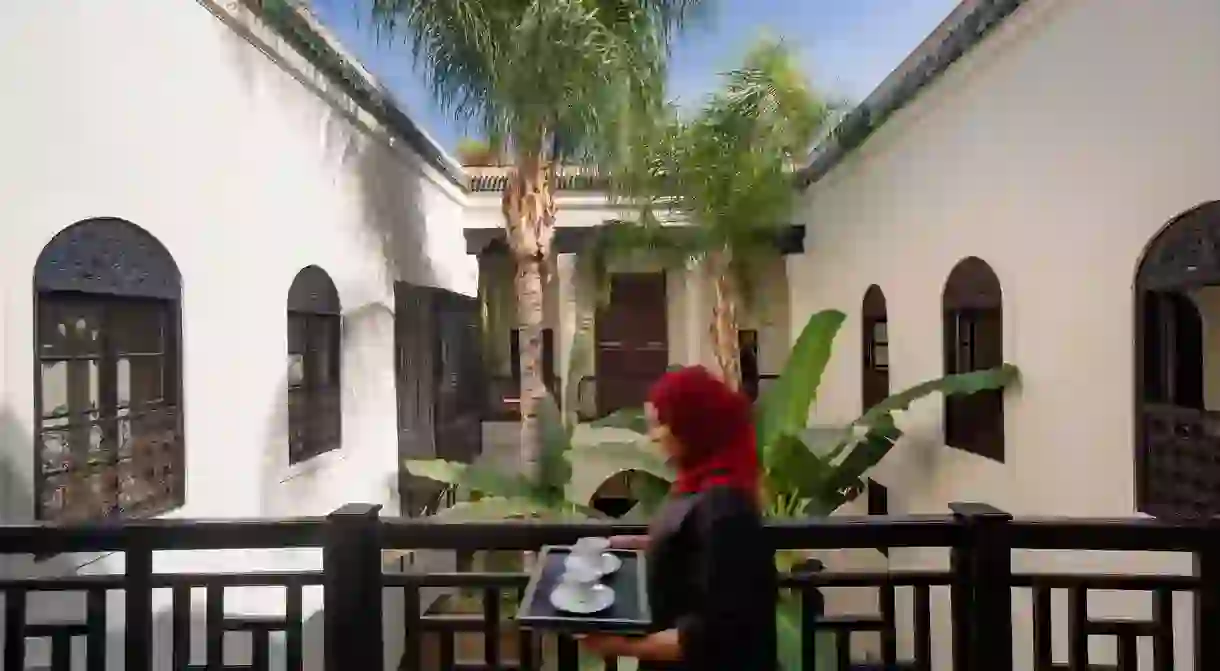A Brief History of Riads, Morocco's Exquisite Accommodation

Riads are the most quintessentially Moroccan accommodation. Bright and airy, a large number of traditional riads have been converted into guesthouses, allowing visitors to live like a local while in Morocco.
Want to learn about Morocco’s architecture? Book Culture Trip’s 13-day Moroccan adventure where our local guide will share their knowledge of this enchanting country.
What is a riad?

Riads take their name from the Arabic word for garden. Perhaps the central feature of a riad is an interior garden, usually with trees and a fountain. A riad generally has two or more levels built around this central garden, with upper balconies overlooking the lower floor. Roof terraces with high walls are also common.
Design of a riad

The lower floor normally has three long and narrow rooms opening onto the garden. Rooms may have doors or curtains, though it is usual for at least one such room to be open, providing an extended area for relaxing and entertaining visitors. Upper levels have more rooms that lead onto the inner balconies. Some rooms have inner windows with shutters and ornamental metalwork, though some just have doors, or curtains, leading to the rooms. High ceilings create a feeling of spaciousness.

A single large door at street level provides access to the riad via a long passageway. There are no outer windows on the lower levels. Any windows are only on the upper levels and they are often small and high up. There are generally no outer windows within the salons.

The inside walls of a riad often have colourful tilework and ornamental plasterwork. It’s fairly standard for designs to include Quranic calligraphy, geometrical patterns and floral images.
Open-topped living

Riads are traditionally open at the top, allowing fresh air, sunlight, birds and, at times, even rain, to enter the property. Pitched roof edges prevent water from sitting and stagnating; the water runs down into the inner gardens. Trees can grow tall and strong. The walled roof terrace surrounds the opening. Today, some riads have glass covering the opening.
Kitchens and bathrooms

Kitchens and bathrooms are normally found on the ground floor, discretely tucked away off the main entrance passageway, as opposed to near the garden. Chimneys in the kitchens let heat and cooking smells rise and dissipate without affecting the rest of the house. Bathrooms usually have a traditional toilet whilst sinks may be situated within the bathroom or just outside. In times gone by, private homes didn’t have showers; people visited the local hammams for cleansing and bathing rituals.
The difference between a riad and a dar

Although many traditional Moroccan homes are today referred to as riads, there is one major difference between a riad and a dar. Whereas riads have an interior garden, dars have an inner courtyard. The general layout and design of each is, however, otherwise very similar. Smaller apartment-like properties are called dourias.
Background of riads

Riads are only found in the medinas (old walled centres) of a Moroccan city. Practically, building upwards, rather than outwards, allowed families to enjoy more living space in areas where land was scarce or at a premium. The fact that riads have no outer windows meant that properties could be built adjoining each other on up to three sides. This is a large reason why the medinas are often a web of interconnected buildings and narrow passageways.

The architectural design of riads can be traced back to the Roman era. It is thought that the riad is an adaptation of a typical Roman villa. Artisans from Andalusia provided the inspiration for the design of gardens and decorative features.
Historically, riads were the city bases for wealthier families, like courtiers and tradespeople. Other medina-dwelling people lived in dars or dourias.
Popularity of riads in Moroccan society

The inward-focus of life in a riad let families enjoy privacy. This was especially important given the Islamic beliefs of much of Moroccan society; women could enjoy solace within the walls of their home, with no outer windows to threaten their private life. This is also why terraces had high walls; to allow women to work, wash clothes, or relax freely with some mint tea on the rooftop. A whole different cloistered world could, and still can, be found behind the sturdy riad doors.

Although guesthouse-style riads have seen many alterations and renovations over the years – with one of the main changes including the addition of modern bathrooms – a stay in a riad is still a great way to experience life in Morocco’s bustling medinas.













